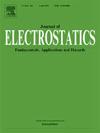Experimental study on the optimization of electrostatic precipitator performance of crenelated dust collection plate
IF 2.1
4区 工程技术
Q3 ENGINEERING, ELECTRICAL & ELECTRONIC
引用次数: 0
Abstract
To investigate the influence of dust-collecting plate structures on electrostatic precipitators (ESPs), an experimental approach was employed to compare the dust removal performance of four plate types—flat plate, triangular plate, corrugated plate, and crenelated plates (CrPs)—under varying wind speeds and voltages for optimal selection. The wavelength(λ) and amplitude(A) parameters of the optimal crenelated plate were further optimized, and its dust removal efficiency for different particle sizes was explored. Results show that the crenelated plate effectively improves electric field distribution and enhances corona discharge, demonstrating the best dust removal performance. Compared with flat plates, crenelated plates with different wavelengths and amplitudes significantly improve efficiency under various voltage and wind speed conditions, with amplitude exerting a more pronounced effect than wavelength. The optimal performance is achieved by a crenelated plate with 150 mm wavelength and 60 mm amplitude. Dust removal efficiency increases with particle size, reaching 82.49 % for 3 μm and 99.34 % for 20 μm particles at 50 kV and 0.5 m/s. The findings provide a reference for the design of electrode plate structures in practical applications.
多孔集尘板静电除尘器性能优化的实验研究
为了研究集尘板结构对静电除尘器(esp)的影响,采用实验方法比较了不同风速和电压下平板、三角板、波纹板和槽形板(CrPs)四种集尘板的除尘性能,以进行最佳选择。对优化后的圆孔板的波长(λ)和振幅(A)参数进行了进一步优化,并探讨了不同粒径下圆孔板的除尘效率。结果表明,空心板有效改善了电场分布,增强了电晕放电,表现出最佳的除尘性能。与平板相比,不同波长和振幅的槽形板在不同电压和风速条件下均显著提高了效率,且振幅的作用比波长的作用更明显。采用波长为150mm、振幅为60mm的圆孔板达到最佳性能。在50 kV、0.5 m/s速率下,3 μm粒子的除尘效率达到82.49%,20 μm粒子的除尘效率达到99.34%。研究结果可为实际应用中电极板结构的设计提供参考。
本文章由计算机程序翻译,如有差异,请以英文原文为准。
求助全文
约1分钟内获得全文
求助全文
来源期刊

Journal of Electrostatics
工程技术-工程:电子与电气
CiteScore
4.00
自引率
11.10%
发文量
81
审稿时长
49 days
期刊介绍:
The Journal of Electrostatics is the leading forum for publishing research findings that advance knowledge in the field of electrostatics. We invite submissions in the following areas:
Electrostatic charge separation processes.
Electrostatic manipulation of particles, droplets, and biological cells.
Electrostatically driven or controlled fluid flow.
Electrostatics in the gas phase.
 求助内容:
求助内容: 应助结果提醒方式:
应助结果提醒方式:


